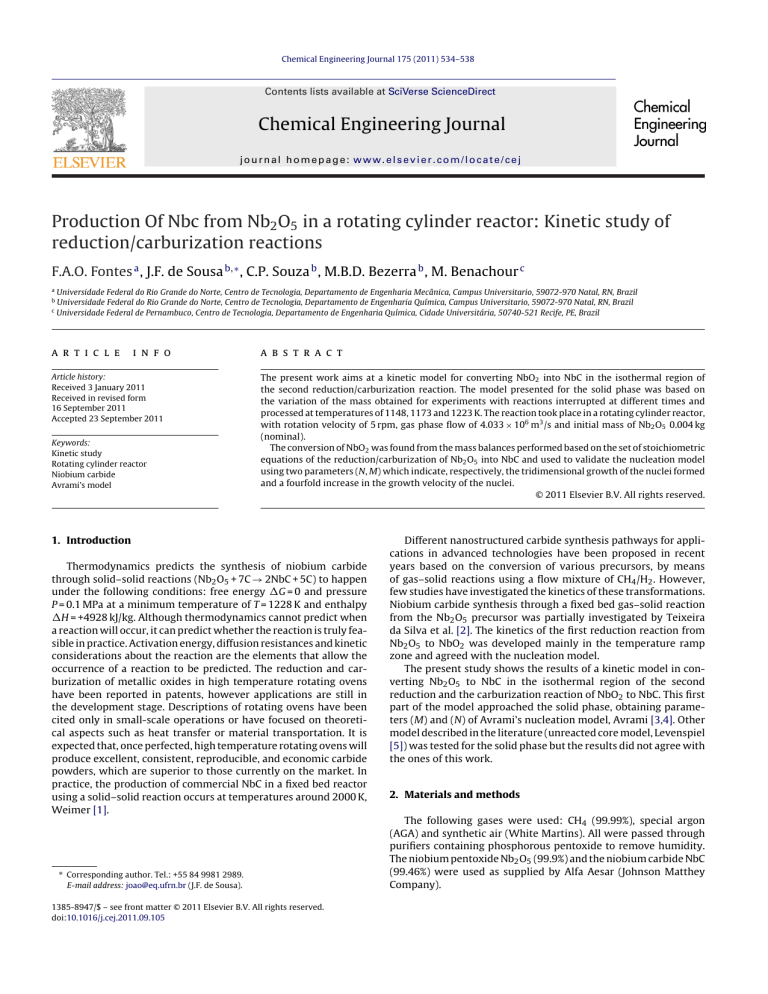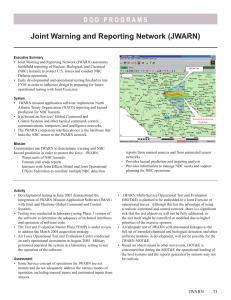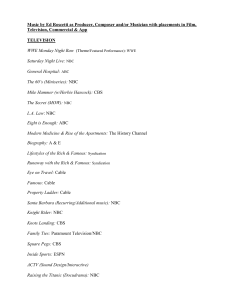
Chemical Engineering Journal 175 (2011) 534–538
Contents lists available at SciVerse ScienceDirect
Chemical Engineering Journal
journal homepage: www.elsevier.com/locate/cej
Production Of Nbc from Nb2 O5 in a rotating cylinder reactor: Kinetic study of
reduction/carburization reactions
F.A.O. Fontes a , J.F. de Sousa b,∗ , C.P. Souza b , M.B.D. Bezerra b , M. Benachour c
a
b
c
Universidade Federal do Rio Grande do Norte, Centro de Tecnologia, Departamento de Engenharia Mecânica, Campus Universitario, 59072-970 Natal, RN, Brazil
Universidade Federal do Rio Grande do Norte, Centro de Tecnologia, Departamento de Engenharia Química, Campus Universitario, 59072-970 Natal, RN, Brazil
Universidade Federal de Pernambuco, Centro de Tecnologia, Departamento de Engenharia Química, Cidade Universitária, 50740-521 Recife, PE, Brazil
a r t i c l e
i n f o
Article history:
Received 3 January 2011
Received in revised form
16 September 2011
Accepted 23 September 2011
Keywords:
Kinetic study
Rotating cylinder reactor
Niobium carbide
Avrami’s model
a b s t r a c t
The present work aims at a kinetic model for converting NbO2 into NbC in the isothermal region of
the second reduction/carburization reaction. The model presented for the solid phase was based on
the variation of the mass obtained for experiments with reactions interrupted at different times and
processed at temperatures of 1148, 1173 and 1223 K. The reaction took place in a rotating cylinder reactor,
with rotation velocity of 5 rpm, gas phase flow of 4.033 × 106 m3 /s and initial mass of Nb2 O5 0.004 kg
(nominal).
The conversion of NbO2 was found from the mass balances performed based on the set of stoichiometric
equations of the reduction/carburization of Nb2 O5 into NbC and used to validate the nucleation model
using two parameters (N, M) which indicate, respectively, the tridimensional growth of the nuclei formed
and a fourfold increase in the growth velocity of the nuclei.
© 2011 Elsevier B.V. All rights reserved.
1. Introduction
Thermodynamics predicts the synthesis of niobium carbide
through solid–solid reactions (Nb2 O5 + 7C → 2NbC + 5C) to happen
under the following conditions: free energy G = 0 and pressure
P = 0.1 MPa at a minimum temperature of T = 1228 K and enthalpy
H = +4928 kJ/kg. Although thermodynamics cannot predict when
a reaction will occur, it can predict whether the reaction is truly feasible in practice. Activation energy, diffusion resistances and kinetic
considerations about the reaction are the elements that allow the
occurrence of a reaction to be predicted. The reduction and carburization of metallic oxides in high temperature rotating ovens
have been reported in patents, however applications are still in
the development stage. Descriptions of rotating ovens have been
cited only in small-scale operations or have focused on theoretical aspects such as heat transfer or material transportation. It is
expected that, once perfected, high temperature rotating ovens will
produce excellent, consistent, reproducible, and economic carbide
powders, which are superior to those currently on the market. In
practice, the production of commercial NbC in a fixed bed reactor
using a solid–solid reaction occurs at temperatures around 2000 K,
Weimer [1].
∗ Corresponding author. Tel.: +55 84 9981 2989.
E-mail address: joao@eq.ufrn.br (J.F. de Sousa).
1385-8947/$ – see front matter © 2011 Elsevier B.V. All rights reserved.
doi:10.1016/j.cej.2011.09.105
Different nanostructured carbide synthesis pathways for applications in advanced technologies have been proposed in recent
years based on the conversion of various precursors, by means
of gas–solid reactions using a flow mixture of CH4 /H2 . However,
few studies have investigated the kinetics of these transformations.
Niobium carbide synthesis through a fixed bed gas–solid reaction
from the Nb2 O5 precursor was partially investigated by Teixeira
da Silva et al. [2]. The kinetics of the first reduction reaction from
Nb2 O5 to NbO2 was developed mainly in the temperature ramp
zone and agreed with the nucleation model.
The present study shows the results of a kinetic model in converting Nb2 O5 to NbC in the isothermal region of the second
reduction and the carburization reaction of NbO2 to NbC. This first
part of the model approached the solid phase, obtaining parameters (M) and (N) of Avrami’s nucleation model, Avrami [3,4]. Other
model described in the literature (unreacted core model, Levenspiel
[5]) was tested for the solid phase but the results did not agree with
the ones of this work.
2. Materials and methods
The following gases were used: CH4 (99.99%), special argon
(AGA) and synthetic air (White Martins). All were passed through
purifiers containing phosphorous pentoxide to remove humidity.
The niobium pentoxide Nb2 O5 (99.9%) and the niobium carbide NbC
(99.46%) were used as supplied by Alfa Aesar (Johnson Matthey
Company).
F.A.O. Fontes et al. / Chemical Engineering Journal 175 (2011) 534–538
535
Fig. 1. Experimental device.
1.0
2
ln{ln[1/(1-X B)]}
XB
0.6
0.4
0.2
0
-1
N = 2.89
M = 0.001381 h -1
-2
-3
-4
T = 1148 K
-5
8
0.0
2
3
4
5
time(h)
6
7
8.5
9
ln(t-t 0)
8
9.5
10
2
1.0
Experimental data
Estimation
1
ln{ln[1/(1-X B)]}
0.8
XB
Experimental data
Estimation
1
Experimental data
Estimation
0.8
0.6
0.4
0
Experimental data
Estimation
N = 3.03
M = 0.001155 h -1
-1
-2
0.2
4
5
time(h)
6
7
-4
8
8
Experimental data
Estimation
8.5
0
9
ln(t-t 0)
9.5
10
Experimental data
Estimation
2
B
1.0
0.9
0.8
0.7
0.6
0.5
0.4
0.3
0.2
0.1
0.0
2
3
ln{ln[1/(1-X )]}
XB
0.0
2
-3
T = 1173 K
N = 2.84
-1
M = 0.001993 h
-2
-4
T = 1223 K
7
3
4
time(h)
5
6
7.5
8
8.5
ln(t-t 0)
9
9.5
Fig. 2. Conversion of NbO2 to NbC at different temperatures: determination of Kinetic Parameters of Avrami’s Model.
10
536
F.A.O. Fontes et al. / Chemical Engineering Journal 175 (2011) 534–538
Conversion of NbO2 (XB)
Mass variation (Δm)
Molar fraction of methane (fCH4)
Isothermal region
fCH4, Δm, XB
1.0
0.8
0.6
0.4
0.2
Nb2O5
Nb2O5
0.0
0
NbO2
NbO2
NbC
NbO2
NbC
st
nd
1st reaction 1 phase 2 reaction
1
2 t0
3
ts
2nd phase 2nd reaction
4
5 tf
6
time(h)
Fig. 3. Dynamic behavior of concentration of methane, mass variation and conversion of NbO2 at 1223 K.
Fig. 1 shows the device that was designed to carry out the
solid–gas reaction:
O – Electric tubular oven; R – Rotating cylinder reactor; B – Bearings; S – Rotating seals; C – Chromatographer; P – Precursor feed;
Ar – Argon; H2 – Hydrogen; CH4 – Methane; F – Flow meter; Bu –
Gas bubbler; T – Thermocoupler; and G – Gas mixer.
The gas distribution unit contained argon for cleaning (Ar) and
methane and hydrogen for carbothermic reduction (CH4 /H2 ) in
addition to synthetic air (Air) for an SRI 8610/C Gas Chromatographer coupled with a Flame Ionization Detector (FID) used to
monitor the adsorption of methane as well as end of the reaction.
Experimental design was applied to study the kinetics of the
carburization reaction of Nb2 O5 to NbC carrying out experiments
with abrupt interruptions of the reaction at programmed times,
according to the procedure described by Montgomery [6].
This step used a localized experiment which investigated temperatures of 1148, 1173, and 1223 K, with the values of the
remaining operation parameters fixed at central point values
of the response surface methodology (star) used for parameter
optimization (Qm ) and (z) as follows: mass (nominal) of sample mi = 0.004 kg; heating rate ˇ = 0.167 K/s; mixture flow CH4 –H2 ,
Qm = 4 × 10−6 m3 /s; ratio CH4 /H2 , z = 10% (v/v) and cylinder reactor
rotation r = 5 rpm, Fontes [7].
The experiment started with careful weighing of the sample
and cleaning of the rotating cylinder reactor chamber. The sample was then fed in and adjustments were made to the following
trial parameters: reagent flows, temperature and trial duration.
The time intervals when the reactions would be interrupted were
defined, and afterwards, according to the results obtained by X-ray
diffraction analyses, other points of investigation were carried out.
The initial time of the isothermal region (tis ) varies for each temperature, because the heating rate (ˇ = 0.167 K/s) was kept constant at
all temperature levels investigated. The trial was initiated when the
temperature and reaction time controller/programmer activated
the oven. At the end of the established time, the programmer turned
the oven off automatically and at that moment, the CH4 –H2 flow
mixture was removed and substituted by a 1.6 × 10−6 m3 /s argon
flow during cooling until ambient temperature was reached. The
reactor continued to rotate to facilitate dissolution of the material.
The sample was recovered and care was taken to remove it completely in order not to interfere with the results. One sample in each
ten trials was repeated to verify the reliability of the experiments.
All the samples obtained were characterized by X-ray diffraction to
identify the phases present.
In this scientific research, samples were not submitted to the
passivation process. However, the passivation process would be
carried out if the samples were submitted to gas mixture of helium
with 1% O2 . Moreover, the passivation process does not influence
the phase distribution because the phase carbide is already formed
and the low oxygen concentration is not able to change the final
carbide phase.
2.1. Kinetics: solid phase
The present study was based on the set of stoichiometric equations for the carburization of Nb2 O5 to NbC in two stages, as
presented by Kim et al. [8].
Heterogeneous and consecutive reactions:
Nb2 O5(s) + H2(g) → 2NbO2(s) + H2 O(g) (first reaction)
NbO2(s) + 3CH4(g) → NbC(s) + 2CO(g) + 6H2(g) (second reaction)
CH4(g) → C(s) + 2H2(g) (parallel reaction)
In order to validate the model and obtain the parameters M
and N in accordance with experimental data, it was considered the
following hypotheses:
1- Isothermal system.
2- Solids of invariable size (final size of the particle composed of
products equal to the initial size of the NbO2 particle).
3- Piston flow model.
4- Solid phase conversion by the nucleation model.
5- First-order kinetic model for CH4 .
2.2. Solid phase: general equation
Nb2 O5 → 2NbO2 → 2NbC
Calling, Nb2 O5 = A; NbO2 = B; NbC = C, thus: A → 2B → 2C
Mass balances
F.A.O. Fontes et al. / Chemical Engineering Journal 175 (2011) 534–538
537
Defining for the first reaction the conversion of Nb2 O5 to NbO2
by Eq. (1):
mi − mo
(2)
∗ = 2M M (stoichiometric conversion factor of the
Being fc1
B A
first reaction), fpd = 0.96 (mass loss factor estimated for loading/unloading), nAi : mol of Nb2 O5 at the beginning, nBi : mol of
NbO2 at the beginning, MA , MB , MC : molecular weight of Nb2 O5
(261.82 g/mol), NbO2 (124.91 g/mol) and NbC (104.91 g/mol),
respectively.
Defining for the second reaction the conversion of NbO2 to NbC
by Eq. (3):
XB =
(m(t) − mo )
(mf − mo )
20
30
40
2.3. Validation by Avrami’s nucleation model
The next step was to determine the kinetic parameters of
Avrami’s nucleation model, Avrami [3,4] at temperatures of 1148,
1173 and 1223 K. The solid conversion was determined using the
following Eq. (4):
(4)
where M: growth rate of nuclei; N: geometry of nuclei;
For Avrami’s model:
3. Results and discussion
Fig. 2 shows the results of the experiments performed with reactions interrupted at different times (t) for temperatures of 1148,
1173 and 1223 K, respectively and compared with the model (Eq.
(4)). The results showed a sigmoidal behavior of the conversion
fraction of NbO2 (XB ) agreed with the nucleation model for the
kinetics of the second reaction. It can be observed that the values
determined for the exponent (N) lie around 3, which shows a tridimensional growth of the sphere-shaped nuclei formed, where all
the nuclei are already present at the onset of the second reaction.
The growth velocity of these nuclei, represented by the constant
(M), increases at an approximate proportion of 4:1 between the
temperatures of 1148 and 1173 K, as well as between 1173 and
1223 K.
The standard deviations found when determining parameters
(N) and (M) of Avrami’s model indicate good agreement between
t = 4.17 h
NbO 2 + NbC
t = 3.33 h
NbO 2
t = 0.00 h
Nb 2O5
70
90
80
100
110
120
the experimental values and those expected by the model, as shown
in Fig. 2 for the three temperature levels investigated.
Fig. 3 evidences a reduction in the molar fraction of CH4 , which
could be estimated by Eq. (5), also the curve representing mass
variation (m) which was calculated by Eq. (6) and the conversion
of NbO2 into NbC estimated by Eq. (7), as a function of time. The
conversion for the model was calculated by Eq. (4).
fCH4 =
CCH4
CCH4 ,i
(5)
where CCH4 : methane concentration at a time t, (mol/m3 ), CCH4 ,i :
initial concentration of methane (mol/m3 )
(mi − mt )
(mi − mf )
(6)
The conversion XB was calculate by Eq. (7)
XB =
Fig. 2 shows the experimental values of the conversion of NbO2
versus reaction time (t) as well as the conversion curves obtained
by Avrami’s model for 1148, 1173 and 1223 K, respectively. Parameters (M) and (N) of the model were based on the experimental
values at each temperature, the graphs of ln[ln(1/(1 − XB ))] versus
ln(t-t0 ) referent Eq. (4).
60
NbO 2 + NbC
Fig. 4. X-ray diffraction spectra of the different phases formed as a function of reaction time during the formation of NbC. mi = 0.004 kg, Qm = 4.0 × 10−6 m3 /s, z = 10%,
ˇ = 0.167 K/s, r = 0.083 rps, T = 1223 K.
m =
N = 1: one-dimensional growth (needle format).
N = 2: two-dimensional growth (disc format).
N = 3: growing three-dimensional format (sphere format).
50
t = 5.00 h
Difraction angle 2θ
(3)
∗ (mass at the end of the second reaction).
where mf = mo fc2
∗
Being fc2 = MC /MB (stoichiometric conversion factor of the second reaction).
The conversion Eq. (3) of NbO2 to NbC was used to validate
Avrami’s nucleation model, Fontes [7].
XB = 1 − exp[−M(t − to )N ]
NbC
(1)
initial
sample
mass,
mo :
mi :
where
∗ f , m : mass
mass at the end of the first reaction = mi fc1
t
pd
at a time t, Eq. (2), defined as:
m(t) = (nBi + 2nAi )MB + (nBi + 2nAi )XB (MC − MB )
t = 7.33 h
Intensity (arbitrary unit)
XA =
mi − m(t)
(mo − m(t) )MC
(MB − MC )mf
(7)
It is observed in Fig. 2 a decline in the concentration of methane
to the first phase of the second reaction, the attributed to the
consumption of this reagent, followed by an increase in this concentration which can be attributed probably to a loss of activity of
the solid by deposit carbon in its structure.
The production of NbC, being slower, acted as a controlling stage
of the process, according to that previously predicted by Teixeira da
Silva et al. [2], when they studied the kinetics of the first reaction.
The first reduction reaction of Nb2 O5 to NbO2 , according to literature data and those found in the present study, occurred during
the heat ramp interval, while the second carburization reaction of
NbO2 to NbC extends itself to the isothermic region for a period
that depends on the synthesis conditions.
The induction period preceding the second reaction in which
nuclei are formed, starts at the end of the first reaction, where the
concentration of methane begins to decrease. The induction lasts
until the moment that a new peak appears, indicating a reduction
in the concentration of methane at a time to , when the growth
of nuclei present starts along with the conversion of NbO2 into
NbC. This behavior is evidenced by the analysis of X-ray diffraction
(Fig. 4) made with interruption of the reaction. After the instant
when the peak drops in the concentration of methane, it is possible to observe the formation of NbC, being characterized then the
538
F.A.O. Fontes et al. / Chemical Engineering Journal 175 (2011) 534–538
beginning of first phase of the second reaction of carburization.
The first phase ends when the concentration of methane begins to
increase, which corresponds to the beginning of second phase, at
time ts , it evidences, then, the behavior of consumption of methane
in consequence of the deactivation of the solid reagent. The second
and final phase of the second reaction is completed at time tf , which
indicates when the concentration of methane returns to the initial
level. The second reaction only occurs when the first is finished,
which was evidenced in the X-ray spectra. Fig. 3 shows the behavior at 1223 K only, once at other temperatures the process behaves
similarly.
The phases revealed by the characterization of the samples by
X-ray diffraction analysis, are illustrated in Fig. 4 for the isotherm
(T = 1223 K). Characteristic peaks are observed, indicating the formation of NbC, NbO2 and Nb2 O5 as a function of time. Each
diffractogram was obtained as the reaction took place (at different
times) to see which compounds were consumed or produced. It can
be observed that the formation of NbC begins after 3.3 h of reaction
and is fully formed after 5 h, when the chromatogram shows the
pure phases.
4. Conclusion
The conversion of NbO2 to NbC was obtained by means of the
fraction of mass variation for the solid phase.
An induction period precedes the second reaction, when the
nuclei are formed at the end of the first reaction. The induction
period lasts until time to , when growth onset of the nuclei present
takes place as well as the conversion of NbO2 to NbC. The reactions
(first and second) occur consecutively, a fact that is made evident by
the X-ray diffraction analyses performed on the samples obtained
in the interrupted reaction experiments.
The exponent values (N = 3) for Avrami’s model indicate a tridimensional growth of the nuclei formed and the growth velocity of
the nuclei, represented by the constant (M), increases of 3.2 times
among the temperature levels from 1148 to 1173 K and of 5.5 times
among the levels from 1173 to 1223 K.
Acknowledgments
Authors would like to thank the Chemical Engineering Graduate
Program UFRN Natal, Brazil and the CNPq Scholarship Program for
undergraduate students, the LSR UFPB Laboratório de Solidificação
Rápida, the LCT EP USP Laboratório de Caracterização Tecnológica
and LATMAT UFRN Laboratório de Análise Térmica e Materiais.
References
[1] A.W. Weimer, Carbide Nitride and Boride Materials Synthesis and Processing,
Chapman & Hall, New York, 1997.
[2] V.L.S. Teixeira Da Silva, M. Schmal, S.T. Oyama, Niobium carbide synthesis from
niobium oxide: study of the synthesis conditions, kinetics, and solid-state transformation mechanism, Journal of Solid State Chemistry (123) (1996) 168–182
(Academic Press).
[3] M. Avrami, Kinetics of phase change. I: general theory, Journal of Chemical
Physics (7) (1939) 1103–1112.
[4] M. Avrami, Kinetics of phase change. II: transformation-time relations for random distribution of nuclei, Journal of Chemical Physics (8) (1940) 212–224.
[5] O. Levenspiel, Engenharia das Reações Químicas, John Wiley & Sons, Inc., Editora
Edgard Blucher Ltda, 2000, 3a Edição.
[6] D.C. Montgomery, Design and Analysis of Experiments, 3rd ed., John Wiley, New
York, 1991.
[7] F.A.O. Fontes, Prototype of rotating cylinder reactor to obtain NbC: reduction and
carburization reaction kinetics and performance, 2003, 178f, Tese (Doutorado),
Universidade Federal do Rio Grande do Norte, Programa de Pós-Graduação em
Engenharia Química, Natal.
[8] H.S. Kim, G. Bugli, D.G. Mariadassou, Preparation and characterization of niobium
carbide and carbonitride, Journal of Solid State Chemistry (142) (1999) 100–107.




